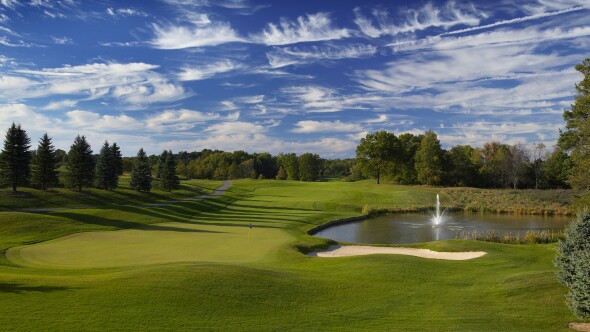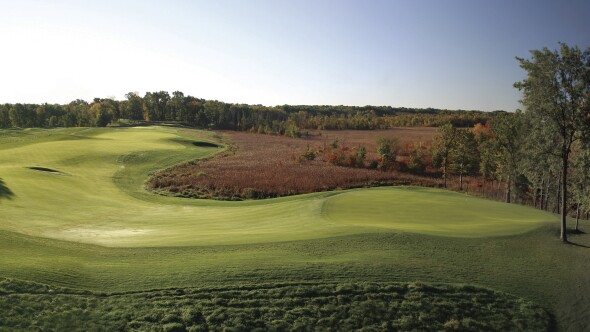Bella Vista Golf Course

About
| Tee | Par | Length | Rating | Slope |
|---|---|---|---|---|
| Championship/Black | 72 | 7011 yards | 74.1 | 136 |
| Blue | 72 | 6532 yards | 71.9 | 134 |
| White | 72 | 6094 yards | 70.0 | 132 |
| Gold | 72 | 5298 yards | 66.4 | 116 |
| Gold (W) | 72 | 5298 yards | 70.9 | 120 |
| Green (W) | 72 | 5039 yards | 69.6 | 116 |
| Hole | 1 | 2 | 3 | 4 | 5 | 6 | 7 | 8 | 9 | Out | 10 | 11 | 12 | 13 | 14 | 15 | 16 | 17 | 18 | In | Total |
|---|---|---|---|---|---|---|---|---|---|---|---|---|---|---|---|---|---|---|---|---|---|
| Championship M: 74.3/137 | 417 | 208 | 552 | 416 | 396 | 423 | 193 | 384 | 501 | 3490 | 387 | 588 | 213 | 374 | 386 | 535 | 416 | 200 | 422 | 3521 | 7011 |
| Blue M: 72.0/134 W: 77.9/140 | 404 | 199 | 538 | 365 | 373 | 396 | 175 | 360 | 484 | 3294 | 367 | 523 | 197 | 353 | 331 | 511 | 376 | 171 | 409 | 3238 | 6532 |
| White M: 70.1/131 W: 75.7/134 | 350 | 178 | 478 | 355 | 368 | 367 | 160 | 345 | 466 | 3067 | 346 | 505 | 144 | 329 | 314 | 494 | 368 | 155 | 372 | 3027 | 6094 |
| Gold M: 65.8/117 W: 70.8/123 | 304 | 145 | 452 | 240 | 215 | 340 | 141 | 333 | 421 | 2591 | 295 | 386 | 138 | 297 | 314 | 418 | 356 | 135 | 368 | 2707 | 5298 |
| Green M: 65.0/113 W: 69.7/119 | 296 | 135 | 448 | 236 | 209 | 328 | 132 | 320 | 421 | 2525 | 288 | 386 | 123 | 297 | 261 | 410 | 311 | 123 | 315 | 2514 | 5039 |
| Handicap | 7 | 3 | 11 | 1 | 17 | 5 | 13 | 9 | 15 | 2 | 4 | 16 | 6 | 14 | 18 | 12 | 10 | 8 | |||
| Par | 4 | 3 | 5 | 4 | 4 | 4 | 3 | 4 | 5 | 36 | 4 | 5 | 3 | 4 | 4 | 5 | 4 | 3 | 4 | 36 | 72 |
| Handicap (W) | 5 | 1 | 7 | 13 | 17 | 3 | 11 | 9 | 15 | 2 | 16 | 10 | 4 | 14 | 18 | 12 | 6 | 8 |
Course Details
Rentals/Services
Practice/Instruction
Policies
Available Facilities
Banquet FacilitiesReviews
Absolute Hidden Gem
Hidden gem is an understatement. For the price, you get a course that’s as well kept as any $60+ course, a challenging track with lots of narrow tee shots, the occasional water feature, and nice greens. It was a chilly-ish Saturday in April and the course was on the empty side, so I can’t speak to pace of play. Would 1000% come back next time i’m in town.
Everything you’ve read is true…
I was a little suspect of the online reviews on Bella Vista but after playing it for the first time, it’s all true.
A.) It’s a gem of a course in the middle of nowhere
B.) It’s a great value for what you pay
C.) It’s challenging but fair
D.) Well maintained
E.) There are few straight, level putts
F.) Very friendly staff plus they have house dogs who are very friendly!
G.) Electric carts with GPS
I played as a single on a Monday morning and pretty much had the course to myself. My only small knock is a lack of amenities. One set of Porta John’s, no ball washers, no bev cart, no broken tee bins on the tee boxes, and the hot dogs at the turn were barely warm. Pretty minor stuff.
Overall impressed.
Lake James Vacation
We played on Father’s Day during a family trip. This course is a great track and I’m great shape. Greens are challenging in all the best ways. We had a ton of fun. Pace of play was good for a Sunday morning and the staff was super friendly. Will definitely come back.
Hidden Gem
I just looked up golf course while driving on I69 south in souther Michigan. I saw the track was close so I got a tee time and played. I have to say this was a great course. It was in great shape, the food was wonderful, the staff was happy to see me. Best greens I have been on all year by far. I will definatly find time to drive up and play again. Well done
Staff friendliness not usually a big deal, as no business wants to be rude, but the staff made us feel like we were regulars. The course is superbly manicured.
Great course.
Didn’t play the best round here but everyone was friendly and the course is beautiful.
Greens were like putting on pool tables.
Great value.
Its fall
First time playing this course on recommendation from some friends. It did not disappoint! Greens have been plugged for winter but still fast and smooth. Wildlife abound with deer and Turkey seen early in the morning. (Tee time was 7:50 a.m.). I thoroughly enjoyed this course and i am looking forward to playing it again soon!
Nice course
The course is beautiful and well maintained. The greens were a bit rough in spots, lots of ball marks (not fixed) and spike marks. Overall great experience!
Casual Golf Reviews
I agree with their claim of being the best kept secret in southern Michigan. This course came highly recommended and it sure didn't disappoint. Scenic layout carved through marshes, woods, a subdivision and also in close proximity to Coldwater Lake. This was a fun course to play with challenging tee shots over marshes and into small landing zones. Firm, fast, undulating greens were tricky to putt on.
Overall Rating 9.62/10
Conditions 10/10
Conditions can't get much better than this. There is nothing I can say that would do it justice. Hemingway could describe it but I can't.
Friendliness 10/10
I got there just in time and had the course to myself, lots of play behind me. This is a a really tough course, forced carries, tight, tree lined fairways and fast greens. It does have multiple tee boxes and gps in the carts which helps.
Returnability 10/10
I didn't want the round to end, can't wait to come back.
Cost 8.5/10
Twilight rate of $25 for 18 and a cart. Good deal considering how nice the conditions are. A little pricey for me and isn't an amount I would like to regularly pay.
Scenic and challenging
It was a perfect day for golf and the course was in great condition. The layout offers a variety of challenges and the greens were definitely one of them. Hitting your ball with a fawn standing just a few feet away is a special memory
Country Course
Enjoyable layout with very nice conditions. Challenging but not overbearing. 18 holes as a foursome played in under 4 hours. Friendly staff.
Charged Twice
I was forced to pay at the course as well as on here with the GolfNow app. So 81 bucks to play a course that cost 41 was a bit of a punch in the gut. I showed the staff my receipt from GolfNow and they said I still need to pay them as well. The came out to my car to make sure I didnt leave even after I stated I already paid the price to to play....nice course though.
Hidden gem
The course is in very good shape. It seems like the course is out in the middle of farmland but when you enter the course/community it is vastly different. It is very beautiful and well kept. The homes that line this course are also upscale and add to the beauty of the course.
The course itself is well maintained, the fairways are a pleasure to hit from and the greens roll true. There is significant undulation in the greens that add to the enjoyment of this course.
I plan to play this course as much as possible whenever I am in the area.



























